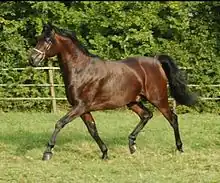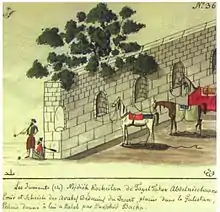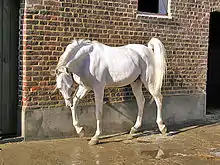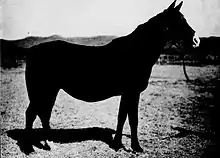Koheilan
Koheilan (Arabic: كحيلان, kuḥaylān) is one of the five major bloodlines of the Arabian thoroughbred horse recognized by the Bedouins, the Al Khamsa. Of tall stature and strong constitution, it owes its name to the beauty of its eyes, set against a black skin that seems naturally enhanced with kohl. The existence of the Koheilan lineage is recounted by the Ottoman traveller Evliya Çelebi in the 17th century, then by the Polish count Wacław Seweryn Rzewuski in the 18th century, who provides a detailed description. He held the horses of the Arabian Najd in the highest esteem, and acquired them for his stud farms. The Koheilan line was widely exported to Central and Eastern Europe, as well as to Russia, where it influenced numerous breeds such as the Najd and Tersk. It has produced the majority of Polish Arabian horses that win endurance ridings.
 Ace of Bask, a typical Koheilan stallion | |
| Country of origin | Saudi Arabia |
|---|---|
| Use | Saddle horse |
| Traits | |
| Height |
|
| Color | Generally grey or chestnut |
Today, this line is mainly bred in Saudi Arabia and Iran.
Terminology
There are variations in the transcription of the Arabic كحيلان: Keheilan[1] Kehilan and Kuhailan,[2] Kocheilan and Najdi Kocheilan,[3] the latter transcription stemming from the origin of these horses, among the Bedouins settled in the Najd heights of central Saudi Arabia.[4] According to Éphrem Houël, the most common French names for the line are: kahel, kahejle, kailhan, koheilan, and finally kochlani.[5]
History
According to Bedouin traditions described by Wacław Seweryn Rzewuski, "Koheyléh" was one of the five mares who returned despite their thirst when the Prophet Muhammad pronounced their name.[6] He is said to have smeared their eyes with kohl, hence their name and that of their offspring, "Koheilan".[6] Koheilan horses are considered to be direct descendants of the Al Khamsa (الخمسة), Muhammad's five favorite mare lines,[4] which Bedouin nomads see as the origin of the Arabian breed, with the quality of belonging or not to the line being transmitted through the mother brood mare.[7][8] In fact, the names of these bloodlines often derive from the Bedouin family who bred them.[9] Orientalist Aleksander Chodźko notes that Koheilan are considered the finest Arabian horses.[10] Bedouin belief attributes to these horses the ability to choose the best path for their rider, thanks to hippomancy.[3]
Roger D. Upton (1873) believes that the Darley Arabian horse, originally from the Aleppo region, was a Koheilan-Ras-El-Fedawi[11] (a controversial theory, with others believing it belonged to the Muniqi lineage).[12] In the 19th century, the name "Koheilan" was given to the horses of the Syrian Desert.[13]
Evliya Çelebi's travel notes
Ottoman traveler Evliya Çelebi (1611–1682) reports that in 1648–1650, the Ottoman Empire bred Koheilan (among other bloodlines) in imperial harems, and supplied them with grass, clover, and the finest grain.[14] Among 20,000 musketeers, he cites cavalrymen riding "Kuheilan" horses.[15]
Travel notes by Count Wenceslas Severin Rzewuski

One of the best-known descriptions is by Count Wacław Seweryn Rzewuski. This Polish-born polyglot traveler wrote a treatise in French during his expedition to the Bedouins of Arabia's Najd, from 1817 to 1819. In it, he proposed a "grading table for horse blood".[16] According to him, the hottest breed, "all blood and fire", is that of the "Bedouin Najdi Kocheilan of the Schamalieh and Hediazet deserts", with a blood temperature of 80 degrees.[17] He then ranks the Kocheilan and the Thoroughbred at 70°.[16]
Rzewuski shows great admiration and attraction for the Koheilan breed of the Najd,[18] which he describes as "unquestionably the noblest horse in the world and often even the most beautiful. His breed is the purest, the most proven. It has never been mixed".[19] His notebook also includes numerous linguistic notes on the Arabic language,[20] and ten pages of genealogical lists of these horses.[21] Among other things, he writes that "these horses are Najdi because they were born in the deserts of the Najd, and Kocheilan because they have the requisite black eye qualities".[22] He also describes Bedouin traditions of horse capture and exchange, with horses captured on caravans (nakisat) being resold to other tribes, informing them of the animals' name and breed, which Rzewuski describes as "a custom of courtesy and respect for the purity of Najdi Kocheilan blood".[23] Defining the breed by controlling genealogy and climate, he naturally places the horses he imports and breeds himself in his stud farms at the top of the blood classification he has established.[16]
Description

According to the University of Oklahoma study, modern breeders of Arabian horses more generally consider the Koheilan lineage to be one of the three great types of the Arabian breed, along with Saklawi and Muniqi.[24] The Koheilan line is renowned for the beauty of its eyes, which are topped by eyelids that give the impression of having been painted black.[25] The head is short, broad between the eyes and in the cheeks.[2] Wacław Seweryn Rzewuski attaches great importance to the color of the skin, which must be black, seeing it as a sign of racial superiority.[26]
The constitution is more solid and stocky than in other lineages:[24] according to the characterization study published in the USSR in 1989, the Koheilan type is distinguished by "prominent body mass, large size, solid construction and the ability to thrive regardless of management conditions". Koheilans show good action and satisfactory stamina.[27] It is a "male-type" lineage, with deep chest, tall stature and great power, reaching a height of 1.52 m.[2] Koheilan symbolizes power and endurance.[28]

Usage
A study of endurance horses in Poland revealed that a significant number are Koheilan Arabs. The "Koheilan Adjuze" line has few winners.[29] The "Kuhailan Afas" line accounts for the highest number of race starts, and the highest rate of wins over 80 km and more.[29]
Influence on European and Russian horse breeds
The line had a particularly important influence on horse breeds in Central and Eastern Europe, as well as in Russia. In the 19th century, these horses were imported in large numbers. However, Bedouins do not use studbooks like Europeans. According to Bernadette Lizet, Wacław Seweryn Rzewuski specified that a hudget (a written attestat) was attached to Koheilan horses from regions other than the Nadj, and a certificate of nobility to Nadji Koheilan,[30] the presence of written attestations being a requirement of Russian, German and Polish importers.[31]
Koheilan I, a grey stallion born at Bábolna National Stud in Hungary in 1922, was exported to Janów Podlaski Stud in Poland, where he became the head of the Arabian racehorse line. Some of its descendants have been exported to the United States.[32] The Bábolna National Stud favors the Koheilan trend among its Arabian half-breeds.[33] The Hungarian Shagya breed is thus partly descended from the Koheilan IV stallion.[34] The line was also exported to Russia,[35] where it influenced the Tersk breed:[36] Koheilan horses form one of the three Arabian lines most exported to this country.[37] The line was also imported into the Shushi region, where local traditions from the 1920s still recall it,[38] and more widely into the Republic of Artsakh, where it has influenced the local breed.[39]
Spread of breeding
"Keheilan" is considered to be an original line of Arabian horse bred in Saudi Arabia.[1] These horses were brought to Egypt, where they gave rise to a line known as "Koheilan-Harkan".[40] In Iran, the Koheilan is recognized as one of the five major lines of the Arabian breed,[41] more specifically the Persian Arabian.[42] In Khuzestan, the prestige of a horse is determined by the family that bred it: the Koheilan horses of the Mojadami family are considered particularly prestigious.[43]
References
- "Keheilan/Saudi Arabia". DAD-IS. Retrieved 24 November 2016.
- Lynghaug, Fran (2009). The Official Horse Breeds Standards Guide : The Complete Guide to the Standards of All North American Equine Breed Associations. MBI Publishing Company LLC. p. 672. ISBN 978-1-61673-171-7.
- Homéric (2012, p. 319)
- CNRS (2003). Techniques & culture (in French). Éditions de la Maison des sciences de l'homme. p. 192.
- Houël, Éphrem. Histoire du cheval chez tous les peuples de la terre: depuis les temps les plus anciens jusqu'à nos jours (in French). Bureau du Journal des Haras. p. 606.
- Homéric (2012, p. 320)
- Schofler (2006, p. 10)
- Głażewska, Iwona (2010). "Speculations on the origin of the Arabian horse breed". Livestock Science. 129 (1–3): 49–55. doi:10.1016/j.livsci.2009.12.009.
- Kucera, Filip (2013). "Arab Horse in the Culture of Orient". Sensus Historiae. 12: 16. ISSN 2082-0860.
- Chodźko, Alexander (1842). Specimens of the Popular Poetry of Persia: As Found in the Adventures and Improvisations of Kurroglou, the Bandit-minstrel of Northern Persia and in the Songs of the People Inhabiting the Shores of the Caspian Sea. Oriental Translation Fund. Translated by Chodźko, Alexander. Brockhaus. p. 592.
- Upton, Roger (1873). Newmarket & Arabia: An Examination of the Descent of Racers and Coursers. Henry S. King. p. 211.
- Johnson, Virginia; Crookshanks, Barbara (2008). Virginia Horse Racing: Triumphs of the Turf. Arcadia Publishing. p. 160. ISBN 978-1625843920.
- Journal des haras, chasses, et courses de chevaux, des progrès des sciences zooïatriques et de médecine comparée (in French). Vol. 7. Parent. p. 293.
- Çelebi, Evliya (1846). Narrative of Travels in Europe, Asia and Africa in the 17th Century. Vol. 1. Oriental Translation Fund, Oriental Translation Fund of Great Britain and Ireland. p. 256.
- Zertal, Adam; Mirkam, Nivi (2016). The Manasseh Hill Country Survey. Culture and History of the Ancient Near East. BRILL. p. 614. ISBN 978-9004312302.
- Lizet, Bernadette (2004). "Le cheval arabe du Nejd et le système des races orientales dans le manuscrit de Wenceslas Severyn Rzewuski" (PDF). Anthropozoologica (in French). 39 (1): 79–97.
- Rzewuski (2002, p. 628)
- Subhi (2017, p. 98)
- Subhi (2017, p. 93)
- Subhi (2017, p. 99)
- Subhi (2017, p. 100, 101)
- Subhi (2017, p. 94)
- Rzewuski (2002, p. 469)
- Hendricks (2007, p. 43)
- Bongianni, Maurizio (1988). Simon & Schuster's Guide to Horses and Ponies. New York: Simon & Schuster. p. 255. ISBN 0-671-66068-3.
- Rzewuski (2002, p. 469)
- Grigorʹevich Dmitriev, Nikolaĭ; Konstantinovich Ėrnst, Lev (1989). Animal genetic resources of the USSR. Food and Agriculture Organization of the United Nations. p. 260. ISBN 9251025827.
- Schiele (1970, p. 21)
- Sobczuk, Dorota (2011). "Characterization of the performance of purebred Arabian horses in endurance riding in Poland in the years 2005–2009" (PDF). Annales universitatis Mariae Curie-SK Ł Odowska Lublin – Polonia. 29.
- Rzewuski (2002, p. 559)
- Lizet (2004, p. 83)
- Kowalczyk, Andra (2007). Tennessee's Arabian Horse Racing Heritage. Images of America. Arcadia Publishing. p. 127. ISBN 978-0738543901.
- Schiele (1970, p. 222)
- Schrishuhn, Debra Kay; Johnson, Diana Miller; Enander, Anita (2008). The Babson influence: a retrospective : the bloodline at the base of some of the world's greatest pedigrees. The Institute for the Desert Arabian Horse. p. 504.
- Graham Hope, Charles Evelyn; Jackson, Noel (1973). The encyclopedia of the horse. Viking Press. p. 336. ISBN 0-7207-0599-1.
- Pickeral, Tamsin (2003). Encyclopedia of horses and ponies. Barnes & Noble Books. p. 384. ISBN 0760734577.
- Graham Hope, Charles Evelyn; Jackson, Noel (1973). The encyclopedia of the horse. Viking Press. p. 336.
- Dechambre, Paul (1921). Traité de zootechnie: Les équidés (in French) (2nd ed.). Librairie agricole de la maison rustique. p. 42.
- Bockarev, K. (1950). "Sovremennaja karabahskaja lošadj" [Karabakh horse in the present day]. Konevodstvo (in Russian) (9): 16–20.
- Piduch (1988, p. 98)
- Hendricks (2007, p. 337-338)
- Fotovati, A. (2000). "Persian Horse Breeds From Ancient Time to Present and Their Rules in Development of World Horse Breeds" (PDF). Asian-Aus. J. Anim. Sci. 13.
- Hendricks (2007, p. 338)
Bibliography
- Forbis, Judith; Ferriss, Joe (1990). Authentic Arabian bloodstock. Ansata Publications. ISBN 0962564400.
- Hendricks, Bonnie Lou (2007). International Encyclopedia of Horse Breeds (2nd ed.). Norman: University of Oklahoma Press. ISBN 978-0-8061-3884-8. OCLC 154690199.
- Homéric (2012). Dictionnaire amoureux du Cheval (in French). Plon - EDI8. ISBN 978-2259218597.
- Piduch, Erwin (1988). Egypt's Arab Horses: History and Cultural Heritage. Kentauros-Verlag. ISBN 3925069038.
- Porter, Valerie; Alderson, Lawrence; Hall, Stephen J. G.; Sponenberg, Dan Phillip (2016). Mason's World Encyclopedia of Livestock Breeds and Breeding (6th ed.). CAB International. p. 1107. ISBN 978-1-84593-466-8. OCLC 948839453.
- Rzewuski, Wenceslas (2002). Impressions d'Orient et d'Arabie. Un cavalier polonais chez les Bédouins (1817-1819) (in French). Paris: José Corti-Muséum national d’histoire naturelle.
- Schiele, Erika (1970). The Arab horse in Europe: history and present breeding of the pure Arab.
- Schofler, Patti (2006). Flight without Wings: The Arabian Horse And The Show World. Rowman & Littlefield. ISBN 1461748925.
- Subhi, Hana (2017). "Voyage du comte Waclaw Seweryn Rzewuski en Arabie 1817-1819 : de la recherche des chevaux à l'intégration dans la société bédouine". Odysseys / Odyssées: Travel Narratives in French / Récits de voyage en français (in French). BRILL. ISBN 978-9004334724.
